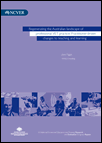Description
This publication explores both the characteristics and examples of innovative teaching and learning practice in Australia. It is based on discussions with practitioners and vocational education and training (VET) managers responsible for teaching and learning. It examines why and how people are changing their pedagogy, and with what results. It found that improvements in teaching and learning practice arise from a perceived need to change. The imperatives to change are usually locally based and dependent for their success on a commitment by all those supporting the learner. Practice is best shared through effective mentoring and by using networks effectively.
Summary
About the research
Teaching and learning is the core business of vocational education and training (VET) providers. That is why in late 2007 the National Centre for Vocational Education Research (NCVER) commissioned two authors to examine the characteristics, and find examples, of innovative teaching and learning practice in Australia and in Europe.
This is the Australian report, written by Jane Figgis, whose approach was to talk to managers and practitioners and get close to their field of endeavour. These people were keen to be involved because they concurred with NCVER’s aim of initiating a conversation about their profession. This group of people were also keen to see good ideas translated into practice and to encourage the spread of good practice.
What follows, along with Yvonne Hillier’s separate study of developments in the United Kingdom and Europe, formed the basis of a series of workshops across the country, where NCVER heard how practitioners can best use this research, and gathered further contributions to our knowledge of good teaching and learning in VET.
Key messages
- Six trends in contemporary practice deserve further consideration: using authentic learning tasks as the basis for learning; encouraging peer learning; applying e-learning technologies; using the workplace as the primary site for learning and skill development; personalising learning; and devolving support for teaching and learning so that it is close to the practitioner.
- Practitioners who actively think about changing their practice generally possess four characteristics. They are: reflective; responsive to and respectful of learners; closely engaged with local enterprises; and reach out to learn from and share their own knowledge with other practitioners.
- Networks can help practitioners to foster better professional practice and help them exchange ideas and resources. The companion study by Yvonne Hillier can be found at www.ncver.edu.au/publications/2137.html.
Tom Karmel
Managing Director, NCVER
Download
Related items
An overview of research on innovative teaching and learning practice in Australia is discussed in th… Show more
This overview of research into innovative teaching and learning practice internationally found that… Show more
This publication explores both the characteristics and examples of innovative teaching and learning… Show more
